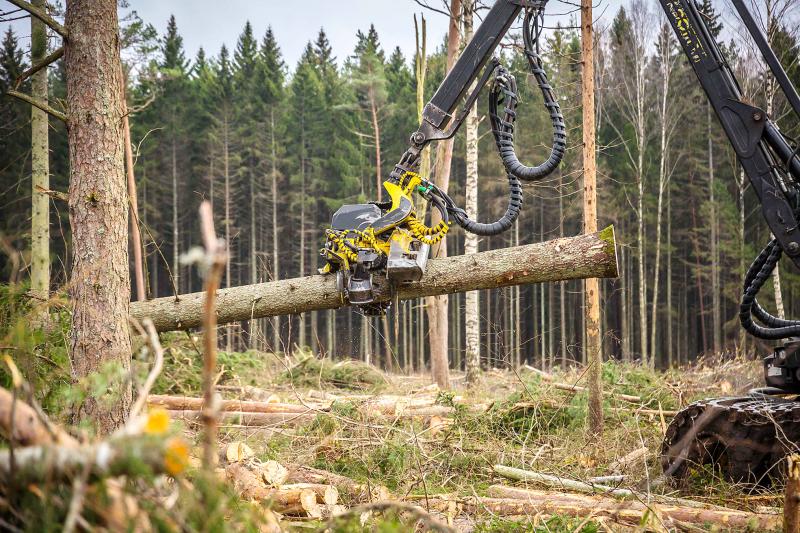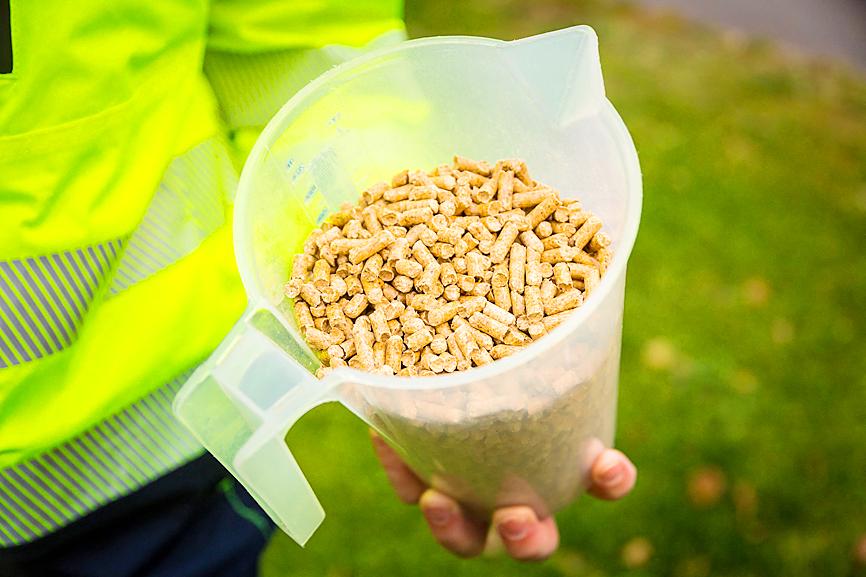Estonia’s thriving wood pellet industry is pitting environmentalists who say it increases logging and harms biodiversity against supporters who say it makes good use of wood that would otherwise go to waste.
The subject is particularly sensitive in the tiny Baltic state once ruled by Moscow, whose forests cover more than half its surface area and are very much part of the national identity.
However, at a plant belonging to Europe’s biggest wood pellet producer, Estonia’s AS Graanul Invest, Mihkel Jugaste, the company’s head of quality and certification systems, defended the industry.

Photo: AFP
“Wood only comes to us when sawmill or plywood factories reject it,” Jugaste said over the sounds of machinery turning logs into sawdust and compacting them into pellets.
Wood pellets are a type of biofuel that can be used in special pellet stoves or central heating furnaces for homes.
They are also used on a larger scale.

Photo: AFP
The former coal-fired power station of Drax in the UK now runs partially on wood pellets, including some from Estonia.
Environmentalists say biomass demand in western Europe is causing an intensification of logging in places such as Estonia, including in protected areas, and the use of techniques such as clearcutting in which entire areas of forest are destroyed.
They say that bird species such as the black grouse and woodlark are under threat from the logging, with woodland bird numbers falling by about one-quarter over the past two decades.

Photo: AFP
Their warnings have been heard in Brussels, and the European Commission earlier this year initiated infringement proceedings against Estonia for failing to ensure environmental impact assessments before issuing logging permits in these areas.
“The intensity of Estonian forest management is too high and pellet production within the forestry industry plays an important role,” said Siim Kuresoo, forest program coordinator at the Estonian Fund for Nature.
“The initial idea of allowing wood to be burned as renewable energy was only to lessen the waste of the industry. Now it has grown into a big industry by itself,” Kuresoo said.
Wood and wood product exports make up about 10 percent of Estonia’s total, and the value rose by 48 percent to 165 million euros (US$185.46 million) for the 12 months through August compared with a year earlier, official figures showed.
Graanul has also reported that its revenues last year rose to 438.9 million euros from 401.7 million euros in 2019.
Jugaste said his company respects and would continue to abide by any environmental protection regulation, but added that sometimes stakeholders disagree on what the rules should be.
“We, as a wood processor, cannot really decide for them,” he said.
“As long as experts make a decision about the protection status or the protection territory and that list is given to us, then we can protect it 100 percent,” he said.
An article in Nature Research last year found that there had been an 85 percent increase in logged areas in Estonia from 2016 to 2018 compared with 2004 to 2015 — one of the largest expansions in the EU.
At the same time, thanks to natural reforestation and planting, the overall forested area in Estonia last year increased to 2.3 million hectares from 2.2 million hectares in 2001.
The issue in Estonia is part of a wider European debate over whether wood pellets can be considered a carbon-neutral energy source as long as there is replanting of trees.
Many say they cannot because burning wood is as dirty as coal and trees take many years to grow back.
Taavi Ehrpais, a forest owner in northwest Estonia, said only about 10 percent of his timber — the lowest quality pieces — would end up in a pellet factory.
Ehrpais, who is also the head of Vardi Metsauhistu, a forest management organization, said it was “an unbelievable myth” that the wood pellet industry was leading to an increase in logging.
Ehrpais also defended logging laws, saying they are “very strict” and guarantee biodiversity.

Taiwan Semiconductor Manufacturing Co (TSMC, 台積電) has secured three construction permits for its plan to build a state-of-the-art A14 wafer fab in Taichung, and is likely to start construction soon, the Central Taiwan Science Park Bureau said yesterday. Speaking with CNA, Wang Chun-chieh (王俊傑), deputy director general of the science park bureau, said the world’s largest contract chipmaker has received three construction permits — one to build a fab to roll out sophisticated chips, another to build a central utility plant to provide water and electricity for the facility and the other to build three office buildings. With the three permits, TSMC

The DBS Foundation yesterday announced the launch of two flagship programs, “Silver Motion” and “Happier Caregiver, Healthier Seniors,” in partnership with CCILU Ltd, Hondao Senior Citizens’ Welfare Foundation and the Garden of Hope Foundation to help Taiwan face the challenges of a rapidly aging population. The foundation said it would invest S$4.91 million (US$3.8 million) over three years to foster inclusion and resilience in an aging society. “Aging may bring challenges, but it also brings opportunities. With many Asian markets rapidly becoming super-aged, the DBS Foundation is working with a regional ecosystem of like-minded partners across the private, public and people sectors

RUN IT BACK: A succesful first project working with hyperscalers to design chips encouraged MediaTek to start a second project, aiming to hit stride in 2028 MediaTek Inc (聯發科), the world’s biggest smartphone chip supplier, yesterday said it is engaging a second hyperscaler to help design artificial intelligence (AI) accelerators used in data centers following a similar project expected to generate revenue streams soon. The first AI accelerator project is to bring in US$1 billion revenue next year and several billion US dollars more in 2027, MediaTek chief executive officer Rick Tsai (蔡力行) told a virtual investor conference yesterday. The second AI accelerator project is expected to contribute to revenue beginning in 2028, Tsai said. MediaTek yesterday raised its revenue forecast for the global AI accelerator used

BREAKTHROUGH TECH: Powertech expects its fan-out PLP system to become mainstream, saying it can offer three-times greater production throughput Chip packaging service provider Powertech Technology Inc (力成科技) plans to more than double its capital expenditures next year to more than NT$40 billion (US$1.31 billion) as demand for its new panel-level packaging (PLP) technology, primarily used in chips for artificial intelligence (AI) applications, has greatly exceeded what it can supply. A significant portion of the budget, about US$1 billion, would be earmarked for fan-out PLP technology, Powertech told investors yesterday. Its heavy investment in fan-out PLP technology over the past 10 years is expected to bear fruit in 2027 after the technology enters volume production, it said, adding that the tech would